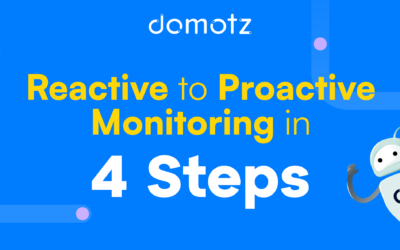As a Managed Service Provider (MSP), your organization has the critical role of remotely managing IT infrastructures and/or end-user systems. That is to say, time management is critical when there are multiple projects on the table all with high-priority.
You know this firsthand if you offer services such as network administration, cybersecurity, cloud services, data backup, recovery, and even help desk support. As an MSP, you do it all, and when you eliminate common MSP time wasters, you deliver true advantages to your clients efficiently.
Let’s be honest, even your best employees can continuously improve their time management skills. So it helps to periodically remind ourselves to run a quick audit of how we allocate our time and how can generate more efficiency in our daily work routine.
Here below are some suggestions on how to increase operational efficiency. We’ll be covering the top five MSP time wasters and how to deal with them:
- Unclear Objectives and Lack of Organization and Planning
- Unproductive Meetings
- Multitasking
- Reactive vs Proactive Approach
- Using Outdated Technology and Equipment
1) Unclear Objectives and Lack of Organization and Planning
It may seem obvious, but it takes much longer to get there if you’re not clear on where you’re going. Unclear objectives, lack of organization, and planning lead to significant time loss and can be one of the biggest MSP time wasters.
If you’re unclear about what you’re working on or what outcome you expect, staying motivated and taking action can be challenging. You may waste your time on tasks that don’t contribute to anything significant.
You’ve likely seen this before, right?
Quick tips on how to identify signs of a poor organization:
- Lack of organizational structure: Avoid mismatched hierarchies, set clear roles, and use up-to-date processes and systems. For instance, if your MSP business is small or medium, you may benefit from a flat organizational structure. This allows for more open communication and collaboration. If you have a larger company, you may need to set up a more functional or divisional model that includes multiple layers of management.
- Unclear objectives: Be sure you have clear goals and timelines to achieve more. Don’t forget to share them with your employees too. Your objectives should be specific, measurable, achievable, on-task, and timely. According to various studies, clearly defined goals are at least 40% more effective when written down.
- Poor planning: Poor planning can often lead to project failure. A proper MSP business plan is essential for a successful business. It will help you identify your strengths and weaknesses and find opportunities to achieve more.
2) Unproductive Meetings
We understand that meetings take up a lot of time in today’s modern way of working. When there is no planning though, they can be highly inefficient. Preparing ahead of time is critical to make sure meetings are productive.
Unproductive meetings consume a significant amount of time. According to the career expert website Zippia, organizations spend approximately 15% of their time on meetings. More than 7% of those meetings are not productive. Read more statistics about meetings here.
We’re not suggesting that all meetings should be canceled as they generate inefficiency, but it’s important to periodically evaluate meetings’ efficiency.
Quick tips on improving meeting culture:
- Set up a clear agenda: Your meetings should have a clear agenda, including ideal attendees, to avoid long discussions that lead nowhere.
- Assign clear roles and responsibilities: Before the meeting, ensure everyone knows who’s leading the discussion, who’s responsible for making decisions, and who’s taking notes. A quick reminder that someone’s input is requested after a meeting can increase engagement.
- Follow-up: Whether you meet with your manager, a potential client, or a colleague, you typically need to follow up for the next steps. You can gain clarity and track progress by learning how to write a follow-up email.
- Keep the short! You’ll benefit by cutting meeting times in half and sticking to a strict agenda. Stay on schedule to save time. This way, you will develop and deliver actionable meeting outcomes for each team member in attendance.
3) Multitasking
Multitasking was once a brag-worthy skill. Now we know it’s one of the top time-wasting habits we’re all susceptible to. If you’ve considered multitasking to be efficient, you’re not alone. The truth is it’s a surefire way to become overloaded, make more mistakes, and be less efficient. Instead, you’ll see better results when you focus on one thing at a time and give each task the attention required.
You could allocate time for specific tasks and stay with them until they are complete. When multiple things are on the go at the same time, blocking out time into smaller allotments will help you save time overall.
If you want to improve the quality of work and create time you thought you’d never have, stop multitasking. Check out this article about seven reasons why multitasking doesn’t work.
Quick tips on how to stop multitasking:
- Set boundaries: Set healthy boundaries with your managers and colleagues to avoid stress and prevent MSP burnout. Be transparent in communicating your boundaries so the people you work with have clear expectations. Oh, and be sure to set boundaries with your family, too, especially if you often work from home.
- Automate repetitive tasks: Being in the MSP business, we’re sure you use many tools that help you with automation. Improve your automation processes by periodically evaluating the tasks you automate. Consider adopting network management software like Domotz to help you with automation and notifies you when something goes wrong.
- Learn to say no: Break the multitasking habit by learning how to say no. Obviously, it’s easy to say and hard to do. However, you need time to relax between tasks to be effective.
4) Reactive vs. Proactive Approach
There are vital habits for MSP success that your organization can develop to stay ahead of the competition. When you’re reactive instead of proactive, you end up wasting time. You have to constantly put out fires and react to issues as they come up.
In other words, you are in control of expected situations or occurrences, especially if they may negatively impact your business.
On the other hand, being reactive means just waiting for things to happen. Certainly, there are situations where it’s better to be reactive. For instance, some clients need to talk and share their issues but don’t necessarily expect a solution from you. It may be better in this situation to just listen, especially if they don’t ask for a solution.
Quick tips on being a proactive MSP:
- Automate: Identify the most common tickets and automate such requests. Ask your clients and employees if they have ideas on what to automate.
- Optimize: Undoubtedly, some processes can’t go automatically. But can you optimize them? In most cases, you can. Invest some time identifying operations and process you can improve.
- Provide proactive support: Identify issues that you can resolve before they happen. Providing proactive support for your clients can increase customer satisfaction significantly.
Generally, proactive people are high achievers. In most cases, a proactive approach, such as monitoring, regular maintenance, and implementing prevention measures, saves a lot of time. Being proactive will help you develop proactive measures to keep your business safe.
5) Using Outdated Technology and Equipment
As an MSP, you must work smarter. In addition, you must keep pace with the innovation and modernization of systems and processes. As a result, you’re constantly figuring out how to outpace the rapid changes happening regarding technological advances and your client’s demands.
When you use outdated technology and equipment, you waste time. You must plan wisely to expand your resources to meet your client’s needs and do it all without overwhelming your team.
Quick tips on finding the right technology:
- Affordable: Being an MSP means that you use a lot of technology. For example, real-time ticketing systems, disaster recovery solutions, or endpoint management. While it is true that in some cases, you use free software, in other cases, you might need to invest. Write a comprehensive list of requirements for each software you need and then decide where to invest.
- Integrated: Choose partners who satisfy your technology needs. Whether you use PSA software, a messaging app, or an automation system, be sure all these systems work together smoothly. You may need a network monitoring system to manage everything.
- Secure: Research available security tools depending on your security requirements. Test and validate if they satisfy your client’s needs. Implement and integrate with the other tools you already use.
Bonus tip:
Try Domotz network monitoring software to manage all your systems proactively and avoid MSP time wasters. You still don’t have a network monitoring system? Read our article on what is a network management tool and why to use one.
In comparison with many other tools on the market, Domotz is much lower in cost. It includes more than thousands of free integrations available for our users. For example, PSA, Documentation, and Productivity Tools, to hardware like Firewalls, Access points, and Managed switches. Check out the full list of Domotz integrations.
Additionally, Domotz helps your team work more efficiently, providing you with functionalities like automated inventory, alerts, and network security management features.
Unlock your growth with Domotz and start your free trial.
Final Thoughts
Saving time is a good way to save money, delight your customers and ultimately allow your business to grow. Also, choosing the right technology partners makes a big impact on the efficiency of your organization. Focus on the five areas covered in this article about the top MSP time wasters. Utilize a network monitoring software that allows automation and scalability and you will find your operational efficiency dramatically improved over time.
Further reading:
- MSP burnout tips
- MSP success habits
- MSP onboarding checklist
- What is a network management tool and why use one?



